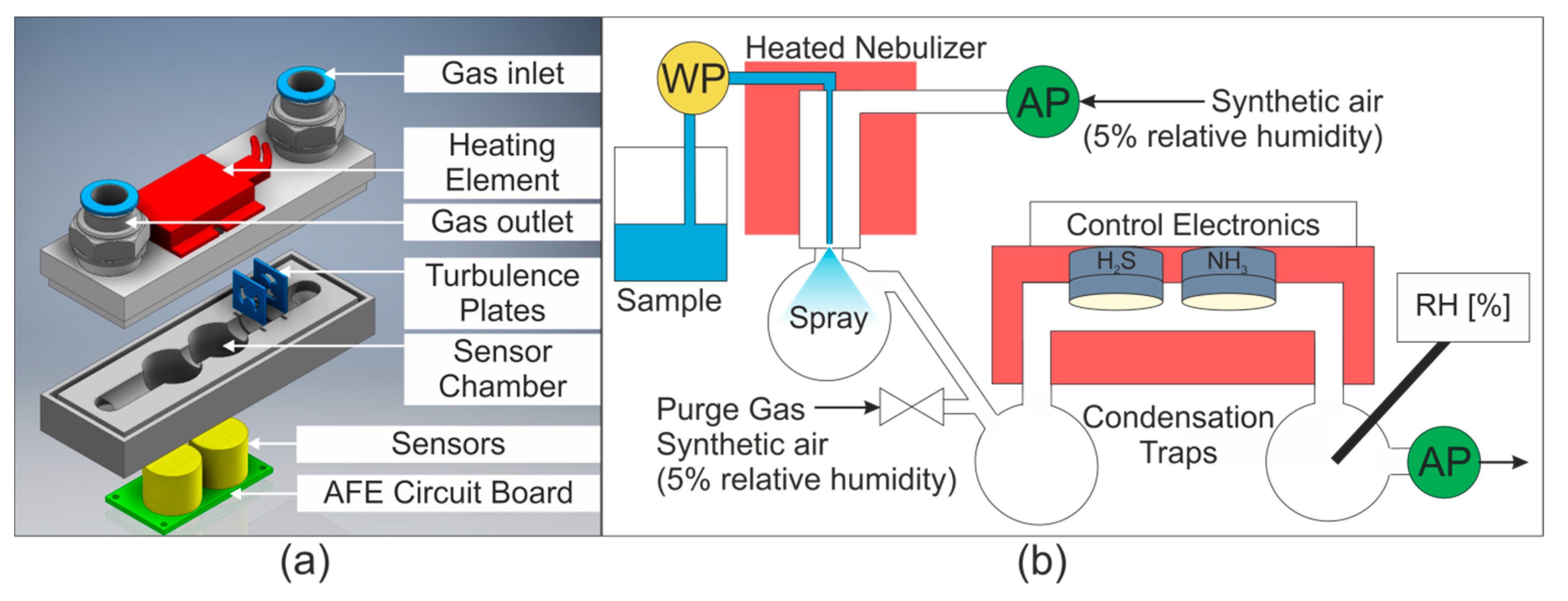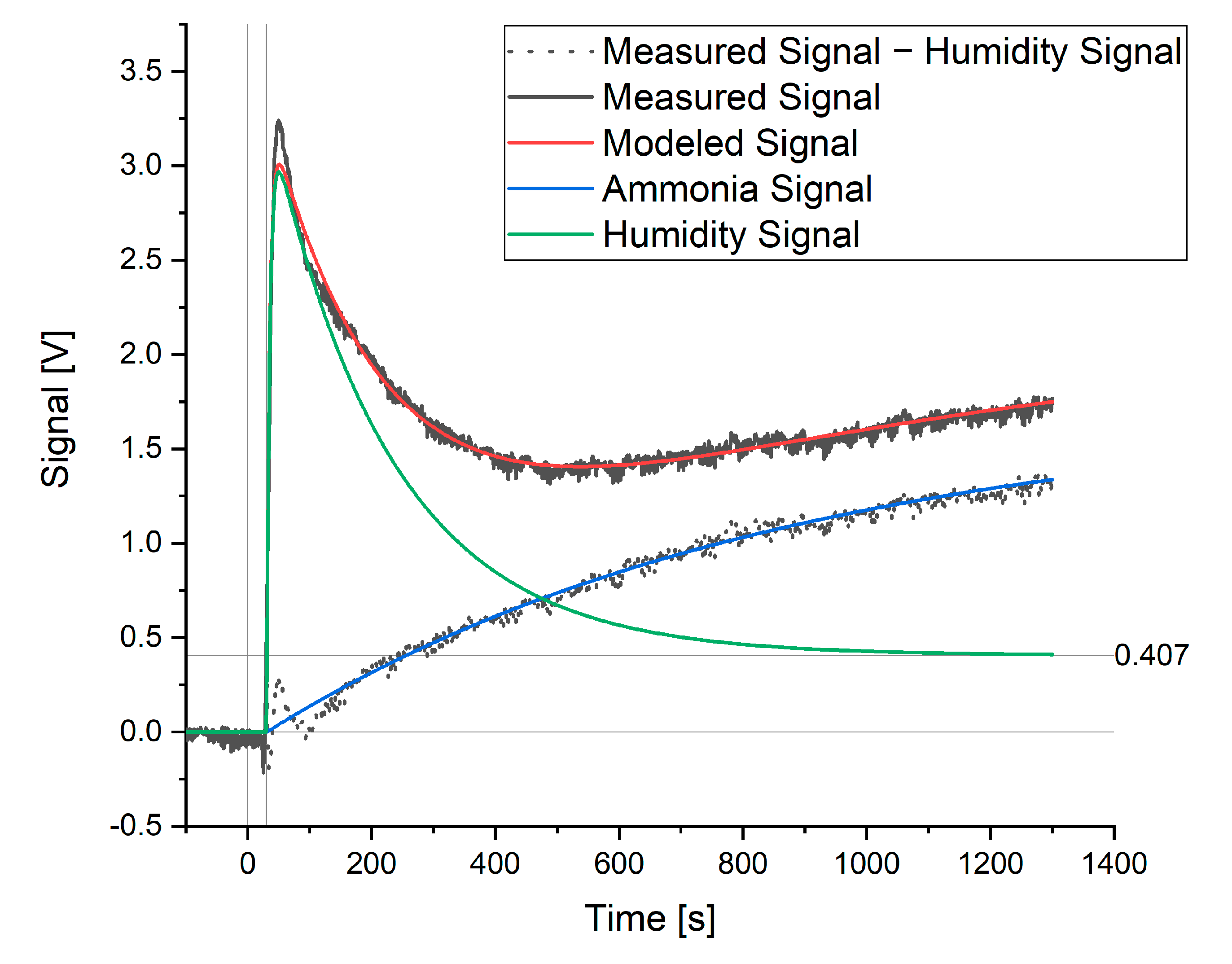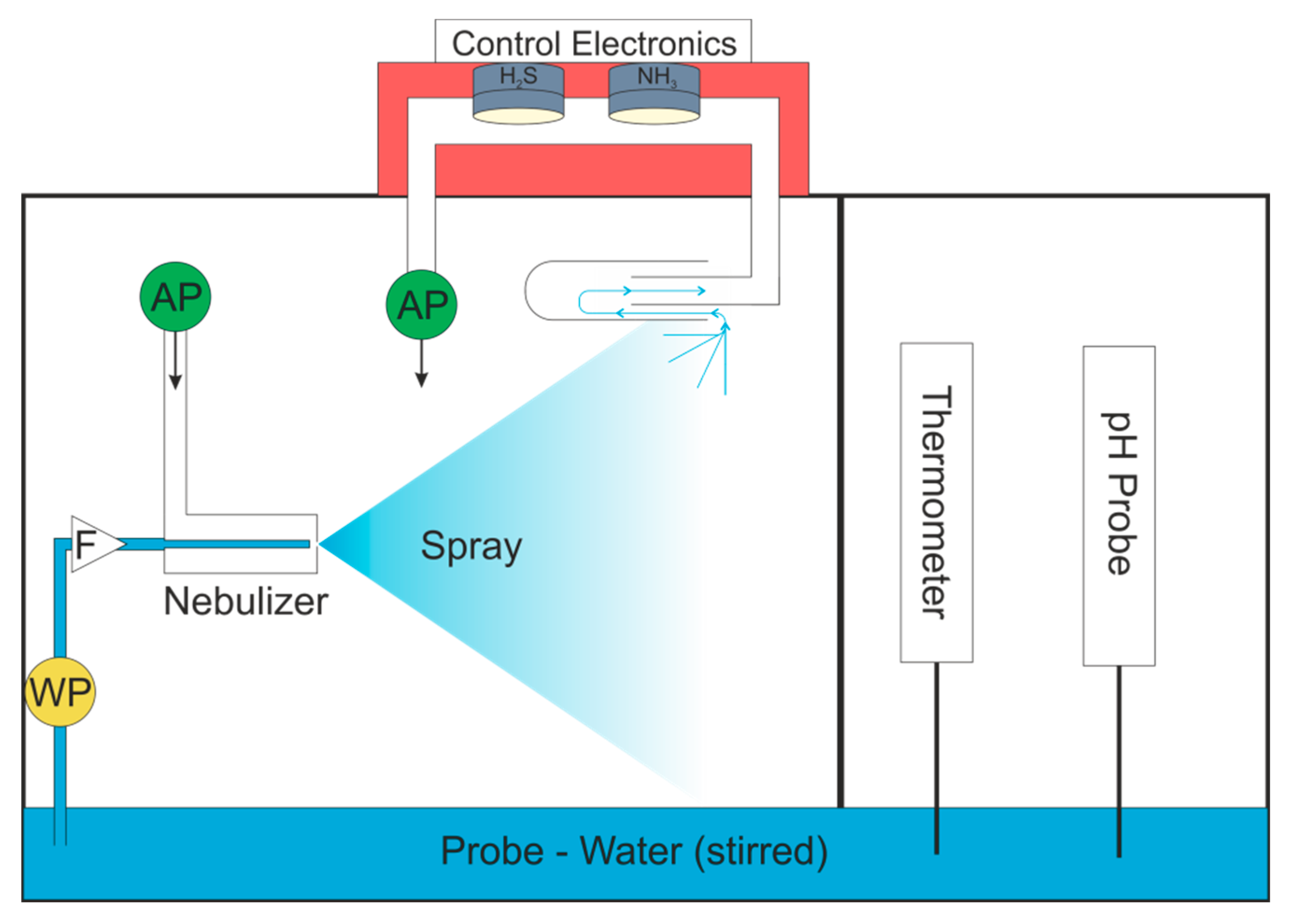Application of Low-Cost Electrochemical Sensors to Aqueous Systems to Allow Automated Determination of NH3 and H2S in Water
Abstract
1. Introduction
2. Materials and Methods
2.1. Sensor Chamber
2.2. Nebulizer and Gas Transport
2.3. Data Acquisition and Processing
3. Results
3.1. Sensor Response and Effect of Humidity
3.2. Development and Validation of Mathematical Model
- t: Time
- a0: Theoretical maximum signal due to ammonia or hydrogen sulfide
- a1: Rate constant of rise in signal due to ammonia or hydrogen sulfide
- a2: Start point of the data (time = 0)
- a3: Rate constant of drop in signal as sensor acclimatizes to new humidity
- a4: Maximum signal caused by humidity
- a5: offset in signal due to humidity
- a6: Rate constant of rise in signal as sensor acclimatizes to new humidity
3.3. Optimization of Measurement Conditions (Water Flow, Temperature, Ionic Strength, and pH)
3.4. Potential for Automation
4. Discussion/Conclusions
Supplementary Materials
Author Contributions
Funding
Conflicts of Interest
References
- Lewis, A.C.; Lee, J.; Edwards, P.M.; Shaw, M.D.; Evans, M.J.; Moller, S.; Smith, K.; Buckley, J.W.; Ellis, M.; Gillot, S.R.; et al. Evaluating the performance of low cost chemical sensors for air pollution research. Faraday Discuss. 2016, 189, 85–103. [Google Scholar] [CrossRef] [PubMed]
- Mead, M.I.; Popoola, O.; Stewart, G.; Landshoff, P.; Calleja, M.; Hayes, M.; Baldoví, J.J.; McLeod, M.; Hodgson, T.; Dicks, J.; et al. The use of electrochemical sensors for monitoring urban air quality in low-cost, high-density networks. Atmos. Environ. 2013, 70, 186–203. [Google Scholar] [CrossRef]
- Jiao, W.; Hagler, G.; Williams, R.; Sharpe, R.; Brown, R.; Garver, D.; Judge, R.; Caudill, M.; Rickard, J.; Davis, M.; et al. Community Air Sensor Network (CAIRSENSE) project: Evaluation of low-cost sensor performance in a suburban environment in the southeastern United States. Atmos. Meas. Tech. 2016, 9, 5281–5292. [Google Scholar] [CrossRef]
- Kumar, P.; Morawska, L.; Martani, C.; Biskos, G.; Neophytou, M.K.-A.; Di Sabatino, S.; Bell, M.; Norford, L.; Britter, R. The rise of low-cost sensing for managing air pollution in cities. Environ. Int. 2015, 75, 199–205. [Google Scholar] [CrossRef]
- Stuetz, R.M.; Fenner, R.; Engin, G. Assessment of odours from sewage treatment works by an electronic nose, H2S analysis and olfactometry. Water Res. 1999, 33, 453–461. [Google Scholar] [CrossRef]
- Hobbs, P.; Misselbrook, T.; Pain, B. Assessment of Odours from Livestock Wastes by a Photoionization Detector, an Electronic Nose, Olfactometry and Gas Chromatography-Mass Spectrometry. J. Agric. Eng. Res. 1995, 60, 137–144. [Google Scholar] [CrossRef]
- Brattoli, M.; De Gennaro, G.; De Pinto, V.; Loiotile, A.D.; Lovascio, S.; Penza, M. Odour Detection Methods: Olfactometry and Chemical Sensors. Sensors 2011, 11, 5290–5322. [Google Scholar] [CrossRef]
- Conti, C.; Guarino, M.; Bacenetti, J. Measurements techniques and models to assess odor annoyance: A review. Environ. Int. 2020, 134, 105261. [Google Scholar] [CrossRef]
- Li, P.; Deng, Y.; Shu, H.; Lin, K.; Chen, N.; Jiang, Y.; Chen, J.; Yuan, D.; Ma, J. High-frequency underway analysis of ammonium in coastal waters using an integrated syringe-pump-based environmental-water analyzer (iSEA). Talanta 2019, 195, 638–646. [Google Scholar] [CrossRef]
- Keith, L.H.; Crummett, W.; Deegan, J.; Libby, R.A.; Taylor, J.K.; Wentler, G. Principles of environmental analysis. Anal. Chem. 1983, 55, 2210–2218. [Google Scholar] [CrossRef]
- Kratochvil, B.; Taylor, J.K. Sampling for chemical analysis. Anal. Chem. 1981, 53, 924A–938A. [Google Scholar] [CrossRef]
- Van Langenhove, H.; Roelstraete, K.; Schamp, N.; Houtmeyers, J. GC-MS identification of odorous volatiles in wastewater. Water Res. 1985, 19, 597–603. [Google Scholar] [CrossRef]
- Sun, J.; Hu, S.; Sharma, K.; Keller-Lehmann, B.; Yuan, Z. An efficient method for measuring dissolved VOSCs in wastewater using GC–SCD with static headspace technique. Water Res. 2014, 52, 208–217. [Google Scholar] [CrossRef]
- Mackay, D.; Shiu, W.Y. A critical review of Henry’s law constants for chemicals of environmental interest. J. Phys. Chem. Ref. Data 1981, 10, 1175. [Google Scholar] [CrossRef]
- Henry, W., III. Experiments on the quantity of gases absorbed by water, at different temperatures, and under different pressures. Philos. Trans. R. Soc. Lond. 1803, 93, 29–274. [Google Scholar] [CrossRef]
- Goldshleger, N.; Grinberg, A.; Harpaz, S.; Shulzinger, A.; Abramovich, A. Real-time advanced spectroscopic monitoring of Ammonia concentration in water. Aquac. Eng. 2018, 83, 103–108. [Google Scholar] [CrossRef]
- Onda, K.; Takeuchi, H.; Okumoto, Y. Mass transfer coefficients between gas and liquid phases in packed columns. J. Chem. Eng. Jpn. 1968, 1, 56–62. [Google Scholar] [CrossRef]
- Gañán-Calvo, A.M. Enhanced liquid atomization: From flow-focusing to flow-blurring. Appl. Phys. Lett. 2005, 86, 214101. [Google Scholar] [CrossRef]
- Matusiewicz, H.; Slachcinski, M.; Almagro, B.; Canals, A. Evaluation of various types of micronebulizers and spray chamber configurations for microsamples analysis by microwave induced plasma optical emission spectrometry. Chem. Anal. 2009, 54, 1219–1244. [Google Scholar]
- Cuartero, M.; Colozza, N.; Fernández-Pérez, B.M.; Crespo, G.A. Why ammonium detection is particularly challenging but insightful with ionophore-based potentiometric sensors—An overview of the progress in the last 20 years. Analyst 2020, 145, 3188–3210. [Google Scholar] [CrossRef]
- Hu, X.; Mutus, B. Electrochemical detection of sulfide. Rev. Anal. Chem. 2013, 32, 247–256. [Google Scholar] [CrossRef]
- Xu, T.; Scafa, N.; Xu, L.-P.; Zhou, S.; Al-Ghanem, K.A.; Mahboob, S.; Fugetsu, B.; Zhang, X. Electrochemical hydrogen sulfide biosensors. Analyst 2016, 141, 1185–1195. [Google Scholar] [CrossRef] [PubMed]
- Athavale, R.; Kokorite, I.; Dinkel, C.; Bakker, E.; Wehrli, B.; Crespo, G.A.; Brand, A. In SituAmmonium Profiling Using Solid-Contact Ion-Selective Electrodes in Eutrophic Lakes. Anal. Chem. 2015, 87, 11990–11997. [Google Scholar] [CrossRef] [PubMed]
- Kühl, M.; Steuckart, C.; Eickert, G.; Jeroschewski, P. A H2S microsensor for profiling biofilms and sediments: Application in an acidic lake sediment. Aquat. Microb. Ecol. 1998, 15, 201–209. [Google Scholar] [CrossRef]
- Jeroschewski, P.; Steuckart, C.; Kühl, M. An Amperometric Microsensor for the Determination of H2S in Aquatic Environments. Anal. Chem. 1996, 68, 4351–4357. [Google Scholar] [CrossRef]
- Brannelly, N.T.; Killard, A.J. A Printed and Microfabricated Sensor Device for the Sensitive Low Volume Measurement of Aqueous Ammonia. Electroanal 2016, 29, 162–171. [Google Scholar] [CrossRef]
- Ogimoto, Y.; Selyanchyn, R.; Takahara, N.; Wakamatsu, S.; Lee, S.-W. Detection of ammonia in human breath using quartz crystal microbalance sensors with functionalized mesoporous SiO2 nanoparticle films. Sens. Actuators B Chem. 2015, 215, 428–436. [Google Scholar] [CrossRef]
- Kosaki, Y.; Takano, K.; Citterio, D.; Suzuki, K.; Shiratori, S. Quartz crystal microbalance sensor using ionophore for ammonium ion detection. J. Nanosci. Nanotechnol. 2012, 12, 563–567. [Google Scholar] [CrossRef]
- Seyama, M.; Iwasaki, Y.; Ogawa, S.; Sugimoto, I.; Tate, A.; Niwa, O. Discriminative Detection of Volatile Sulfur Compound Mixtures with a Plasma-Polymerized Film-Based Sensor Array Installed in a Humidity-Control System. Anal. Chem. 2005, 77, 4228–4234. [Google Scholar] [CrossRef]
- Gomes, M.T.S.R.; Nogueira, P.T.; Oliveira, J. Quantification of CO2, SO2, NH3, and H2S with a single coated piezoelectric quartz crystal. Sensors Actuators B Chem. 2000, 68, 218–222. [Google Scholar] [CrossRef]
- Alphasense. Aan 110 Environmental Changes: Temperature, Pressue and Humidity. Available online: http://www.alphasense.com/WEB1213/wp-content/uploads/2013/07/AAN_110.pdf (accessed on 14 May 2020).
- Dasgupta, P.K.; Dong, S. Solubility of ammonia in liquid water and generation of trace levels of standard gaseous ammonia. Atmos. Environ. 1986, 20, 565–570. [Google Scholar] [CrossRef]
- Hyde, A.M.; Zultanski, S.L.; Waldman, J.H.; Zhong, Y.-L.; Shevlin, M.; Peng, F. General Principles and Strategies for Salting-Out Informed by the Hofmeister Series. Org. Process. Res. Dev. 2017, 21, 1355–1370. [Google Scholar] [CrossRef]
- DeLory, G.E.; King, E.J. A sodium carbonate-bicarbonate buffer for alkaline phosphatases. Biochem. J. 1945, 39, 245. [Google Scholar] [CrossRef] [PubMed]
- Bates, R.G.; Pinching, G.D. Acidic dissociation constant of ammonium ion at 0-degrees to 50-degrees-c, and the base strength of ammonia. J. Res. Natl. Inst. Stand. 1949, 42, 419–430. [Google Scholar] [CrossRef]
- Emerson, K.; Russo, R.C.; Lund, R.E.; Thurston, R.V. Aqueous Ammonia Equilibrium Calculations: Effect of pH and Temperature. J. Fish. Res. Board Can. 1975, 32, 2379–2383. [Google Scholar] [CrossRef]
- Crowley, K.; O’Malley, E.; Morrin, A.; Smyth, M.R.; Killard, A.J. An aqueous ammonia sensor based on an inkjet-printed polyaniline nanoparticle-modified electrode. Analyst 2008, 133, 391. [Google Scholar] [CrossRef]







| Variable. | Expected Change Signal When Variable is Increased | Change in Modeled a0 Coefficient |
|---|---|---|
| Concentration | Linear increase in signal | Linear increase |
| Water Flow | Linear increase in signal | Linear increase |
| Temperature | Linear decrease in ln(signal) with inverse of temperature | Linear increase in signal with temperature 1 |
| pH | Linear increase in inverse of signal with proton concentration | Linear increase in inverse of signal with proton concentration |
© 2020 by the authors. Licensee MDPI, Basel, Switzerland. This article is an open access article distributed under the terms and conditions of the Creative Commons Attribution (CC BY) license (http://creativecommons.org/licenses/by/4.0/).
Share and Cite
Cämmerer, M.; Mayer, T.; Penzel, S.; Rudolph, M.; Borsdorf, H. Application of Low-Cost Electrochemical Sensors to Aqueous Systems to Allow Automated Determination of NH3 and H2S in Water. Sensors 2020, 20, 2814. https://doi.org/10.3390/s20102814
Cämmerer M, Mayer T, Penzel S, Rudolph M, Borsdorf H. Application of Low-Cost Electrochemical Sensors to Aqueous Systems to Allow Automated Determination of NH3 and H2S in Water. Sensors. 2020; 20(10):2814. https://doi.org/10.3390/s20102814
Chicago/Turabian StyleCämmerer, Malcolm, Thomas Mayer, Stefanie Penzel, Mathias Rudolph, and Helko Borsdorf. 2020. "Application of Low-Cost Electrochemical Sensors to Aqueous Systems to Allow Automated Determination of NH3 and H2S in Water" Sensors 20, no. 10: 2814. https://doi.org/10.3390/s20102814
APA StyleCämmerer, M., Mayer, T., Penzel, S., Rudolph, M., & Borsdorf, H. (2020). Application of Low-Cost Electrochemical Sensors to Aqueous Systems to Allow Automated Determination of NH3 and H2S in Water. Sensors, 20(10), 2814. https://doi.org/10.3390/s20102814





